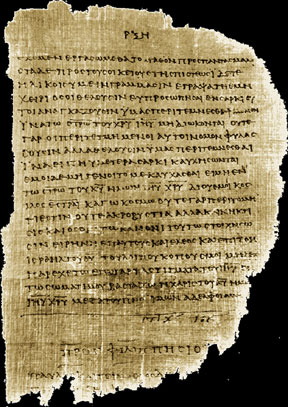Today’s post, as well as several posts to come, are excerpts from my new book, Can We Trust the Gospels? Investigating the Reliability of Matthew, Mark, Luke, and John.
Skeptics who try to cast doubt upon the reliability of the New Testament manuscripts point to the apparently large number of variants they contain. Bart Ehrman, for example, in Misquoting Jesus, suggests that there are 200,000 to 400,000 variants among the New Testament manuscripts. He adds, dramatically, “There are more variations among our manuscripts than there are words in the New Testament.” That sounds ominous, doesn’t it? But, in fact, the data give us no reason to doubt the reliability of the manuscripts. Let me explain why.
We have such a large number of variants because there are so many extant manuscripts. Considering that the four Gospels contain a total of 64,000 words, and we have about 2,000 manuscripts of the Gospels, that’s a lot of potential variants. But as I’ve already shown, having many manuscripts actually increases the likelihood of our getting back to the original text. It also adds to the number of variants, however, which can sound negative to one who isn’t familiar with text-critical issues.
Let me suggest a more hypothetical example that might make clear what I’m saying. This book contains almost 50,000 words. Suppose I asked two people to make copies of this book by hand. Suppose, further, that they made one mistake every 1,000 words (99.9 percent accuracy). When they finished, each of their manuscripts would have 50 mistakes, for a total of 100. This doesn’t sound too bad, does it? But suppose I asked 2,000 people to make copies of my book. And suppose they also made a mistake every 1,000 words. When they finished, the total of mistakes in their manuscripts would be 100,000. This sounds like a lot of variants—more variants than words in my book, Bart Ehrman would say. But in fact the large number of variants is a simple product of the large number of manuscripts. Moreover, if text critics, lacking access to the original version (the autograph) of my book, were going to try and determine what my original version said, they’d be in a much stronger position if they had 2,000 copies to work from, even though they would be dealing with 100,000 variants. With 2,000 manuscripts, the text critics would be able to evaluate the variants more astutely and come up with something very close to what I originally wrote. If they had only two manuscripts, however, even though these included only 100 variants, they would find it harder to determine what the original manuscript said.
So, the fact “there are more variations among our manuscripts than there are words in the New Testament” isn’t surprising. Nor is it bad news. It is a reflection of the wealth of the manuscript evidence available to us. The actual number of variants represents a tiny percentage of the variants that could have occurred among the manuscripts.
Moreover, the vast majority of variants in the New Testament manuscripts are insignificant, either because they appear so rarely that they are obviously not original, or because they don’t appear in the older manuscripts, or because they don’t impact the meaning of the text. In fact, the majority of variants that show up in enough older manuscripts to impact our reading of the text are spelling variations or errors.16 Text critic Daniel Wallace concludes that “only about 1% of the textual variants” make any substantive difference. And few, if any, of these have any bearing on theologically important matters. If you actually took out of the Gospels every word that was text-critically uncertain, the impact on your understanding of Jesus would be negligible.
Consider, for example, the two most obvious and significant textual variants in the Gospels. One of these appears in John 7:53–8:11, the story of the woman caught in adultery. Virtually all modern translations put this story in brackets, adding a note that says something like, “The earliest manuscripts do not include this passage.” It’s likely that this story is true, but that it was added to John well after the evangelist finished his task. Similarly, the ending of Mark includes a bracketed passage because the old manuscripts do not include anything after Mark 16:8. These two disputed passages, though significant in some ways, do not substantially alter our understanding of Jesus.
More from Beliefnet and our partners

